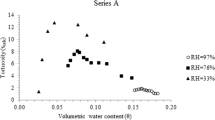Summary
To predict the capillary transport of free liquid during the drying of softwood, it is essential to have knowledge of capillary pressure as a function of moisture content. The dependence of the capillary pressure on the wood's moisture content is predicted with a mechanistic model and measured for isothermal moisture movement in the tangetial direction. The experimental measurements confirm the model which is formulated on the postulate that the menisci that form between the liquid and gas in the tracheid lumens control the magnitude of the capillary pressure. Lumen size variation within an annual growh ring was found to significantly affect the local capillary pressure and indicated that separate flow paths are likely to exist in earlywood and latewood.
Similar content being viewed by others
Abbreviations
- C:
-
Concentration, g/cm3
- D:
-
Diffusion constant of proportionality (cm2/s)
- \(\vec g\) :
-
Gravitational acceleration (cm/s2)
- j:
-
Mass flux (g/s cm2)
- K:
-
Specific permeability (cm2)
- M:
-
Moisture content
- Pc :
-
Capillary pressure (dyne/cm2)
- Pg :
-
Gas phase pressure (dyne/cm2)
- P1 :
-
Liquid phase pressure (dyne/cm2)
- r:
-
Meniscus principle radius of curvature (cm)
- R:
-
Centrifuge radius of rotation (cm)
- S:
-
Saturation
- \(\vec v\) :
-
Velocity (cm/s)
- W:
-
Lumen width (cm)
- z:
-
Distance (cm)
- μ:
-
Dynamic viscosity (dyne s/cm2)
- ϱ:
-
Density (g/cm3)
- σ:
-
Surface tension (dyne/cm)
- ω:
-
Angular velocity (1/s)
References
Collins, R.E. 1961: Flow of Fluids through Porous Materials. New York: Reinhold Publishing
Comstock, G.L. 1967: Longitudinal permeability of wood to gases and nonswelling liquids. Forest Prod. J. 17 (10): 41–46
Comstock, G.L. 1970: Directional permeability of softwood. Wood Fiber 1: 283–289
Gardner, W.H.; Campbell, G.S.; Calissendorff, C. 1972: Systemic and random errors in dual gamma energy soil bulk density and water content measurements. Soil Sci. Soc. Amer. Proc. 36: 393–398
Hart, C.A. 1965: The drying of wood. Technical Report 27. School of Forestry. North Carolina State University
Hawley, L.F. 1931: Wood-liquid relations. U.S. Dept. Agr. Tech. Bull. 148. Washington, D.C.
Petty, J.A. 1975: Relation between immersion time and absorption of petroleum distillate in a vacuum-pressure process. Holzforschung 29: 113–118
Rosen, H.N. 1974: Penetration of water into hardwoods. Wood Fiber 5: 275–287
Siau, J.F. 1971: Flow in Wood. New York: Syracuse University Press
Spolek, G.A. 1981: A model of simultaneous convective, diffusive, and capillary heat and mass transport in drying wood. Ph.D. dissertation, Washington State University
Stamm, A.J. 1963: Permeability of wood to fluids. Forest Prod. J. 13 (11): 503–507
Stamm, A.J. 1964: Wood and Cellulose Science. New York: Ronald Press
Tesoro, F.O.; Choong, E.T.; and Kimbler, O.K. 1974: Relative permeability and the gross pore structure of wood. Wood Fiber 6: 226–232
Whitaker, S. 1977: Simultaneous heat, mass, and momentum transfer in porous media: a theory of drying. Advances in Heat Transfer 13: 119–203
Author information
Authors and Affiliations
Additional information
The authors wish to acknowledge the support of this work by the National Science Foundation under Grant No. CME-7906367. In addition, we must express our appreciation to the Weyerhaeuser Company for providing wood samples for the study and the Department of Agronomy and Soils at Washington State University for allowing us to use their gamma ray densitometry equipment. The comments by Professor J.F. Siau which led to producing a more readable manuscript are greatly appreciated
Rights and permissions
About this article
Cite this article
Spolek, G.A., Plumb, O.A. Capillary pressure in softwoods. Wood Sci.Technol. 15, 189–199 (1981). https://doi.org/10.1007/BF00353471
Received:
Issue Date:
DOI: https://doi.org/10.1007/BF00353471




